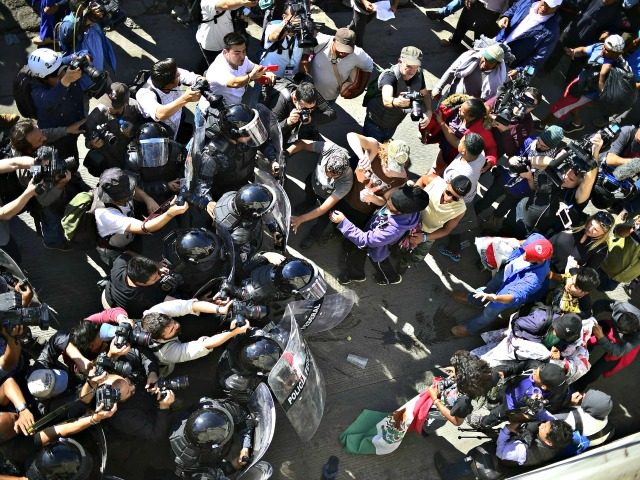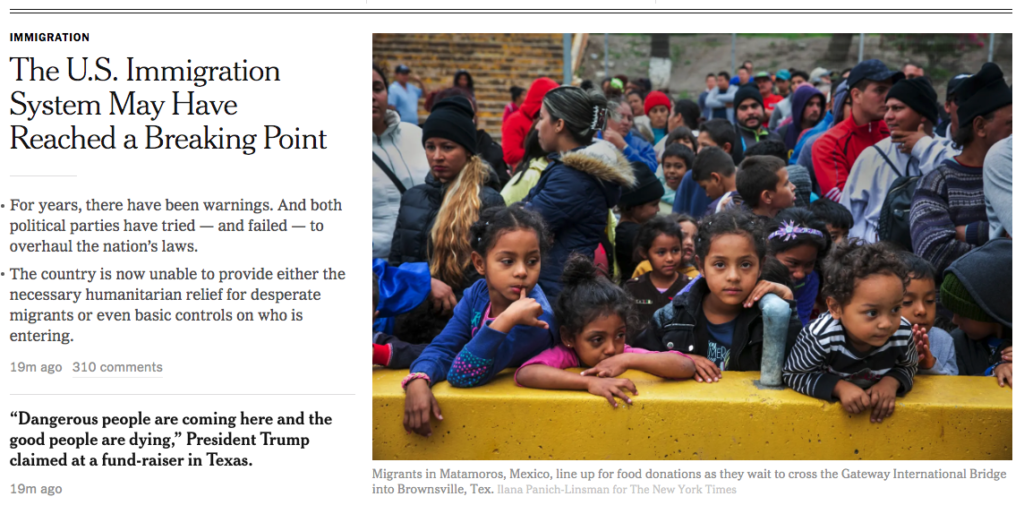The New York Times‘ lead story on Wednesday admitted, “The Border Is Broken” – but it then tries to blame President Donald Trump and his voters for the decisions by hundreds of thousands of foreigners to enter the United States each year.
The editorial-like article was splashed across the newspaper’s webpage,and showcased an image of several migrant girls as it declared:
For years, both political parties have tried — and failed — to overhaul the nation’s immigration laws, mindful that someday the government would reach a breaking point.
That moment has arrived. The country is now unable to provide either the necessary humanitarian relief for desperate migrants or even basic controls on the number and nature of who is entering the United States.
…
In recent days, officials have grasped for ever-more-dire ways to describe the situation: “operational emergency”; “unsustainable”; “systemwide meltdown.”
One top official said simply: “The system is on fire.”
The article marks a notable reversal at the New York Times, whose editors recently argued there is no crisis on the border.
But the New York Times argues that the border breakdown is caused by President Donald Trump’s refusal to welcome a new wave of Central American migrants. The article said:
…the president’s own anti-immigrant rhetoric has helped supercharge the pipeline of migrants from Honduras, Guatemala and El Salvador.
…
… the president has not chosen to prioritize a surge of new resources to the border, which could help ease the overcrowding and suffering that have gripped the migrants and the border communities where they arrive. Instead, Mr. Trump has insisted on simply trying to stop people from getting into the country in the first place — a policy of deterrence that not only has failed but has made the problem worse.
The voters who elected Trump President in 2016 are also blamed for the refusal by Washington to safeguard the border:
But blaming other countries and painting those coming across the border from Mexico as a national security threat has never failed to animate Mr. Trump’s core supporters — the ones who helped deliver him the White House in 2016.
The newspaper downplays the establishment’s conscious decision to keep open multiple border loopholes for a huge wave of foreigners to cross the border into jobs, houses, schools, and neighborhoods.
The newspaper claimed there is no plan to fix the border, but Trump has repeatedly offered his “Four Pillars” package of reforms and a border wall many times — and each time, he has been rejected by a shifting alliance of Democratic and Republican establishment leaders.
The New York Times described the border crash as part of the broader immigration debate, but it declined to describe how ordinary Americans are impacted by the federal government’s support for cheap labor migration, both legal and illegal. Instead, the newspaper describes immigration as an issue that is driven by the needs and concerns of migrants:
“The very nature of immigration to America changed after 2014, when families first began showing up in large numbers,” said the newspaper, as if Americans have no role in deciding immigration.
While blaming Trump and Americans, the New York Times assumes the readers need no evidence to trust the credibility of poor foreigners who stand to gain enormously by lying their way into Americans’ workplaces and neighborhoods — even when the authors allow the migrants to calmly explain their rational reasons:
M.C., a 23-year-old Guatemalan woman who asked to be identified by her initials for safety reasons, received an anonymous letter recently in her hometown, San Marcos, warning her that she would be killed if she did not give the letter writers 65,000 Guatemalan quetzals, nearly $8,500.
M.C., who is three and a half months pregnant, went to the police in San Marcos. Then she got a second letter, warning her to never go to the police again. After she received a third letter, she made the decision to leave for the United States.
“I didn’t want to come here at first, but then I think it’s the best thing for the baby,” M.C. said as she sat in a migrant shelter in the South Texas border city of Brownsville. “Here, he’s going to grow without crime. He can go to school.”
The authors’ assumption that migrants have a right to live in the United State reflect’s the left’s divisive claim that America is a nation of and for immigrants and investors, not a nation of and for American citizens.
The article’s three authors end their piece by reassuring the readers that “M.C.” is just a victim along with most of the other one million migrants who are expected to walk through the asylum loopholes in 2019. Even after describing how “M.C.” rationally plans to pick up the unguarded prize of citizenship for her Guatemalan child, the reporters condescendingly describe the migrants as victims::
In fact, the migrants are mostly victims of the broken immigration system. They are not, by and large, killers, rapists or gang members. Most do not carry drugs. They have learned how to make asylum claims, just as the law allows them to do. And nearly all of them are scared — of being shipped off to Mexico, separated from their children, sent to prison. Scared, especially, of going home.
Read it all here.
Each year, roughly four million young Americans join the workforce after graduating from high school or university.
But the federal government then imports roughly 1.1 million legal immigrants, refreshes a resident population of roughly 1.5 million white-collar guest workers plus roughly 500,000 blue-collar visa workers, and also tolerates about eight million illegal workers.
This federal policy of flooding the market with cheap white-collar graduates and blue-collar foreign labor is intended to boost economic growth for investors.
This policy works by shifting enormous wealth from young employees towards older investors, even as it also widens wealth gaps, reduces high-tech investment, increases state and local tax burdens, hurts children’s schools and college education, pushes Americans away from high-tech careers, and sidelines millions of marginalized Americans, including many who are now struggling with fentanyl addictions.



COMMENTS
Please let us know if you're having issues with commenting.